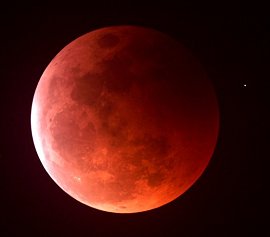
A lunar eclipse on May 15, 2003, photographed by Loyd Overcash of Houston, Texas.
October 13, 2004: According to folklore, October's full moon is called the "Hunter's Moon" or sometimes the "Blood Moon." It gets its name from hunters who tracked and killed their prey by autumn moonlight, stockpiling food for the winter ahead. You can picture them: silent figures padding through the forest, the moon overhead, pale as a corpse, its cold light betraying the creatures of the wood.
The Blood Moon rises this year on Wednesday, Oct. 27th. At first it will seem pale and cold, as usual. And then ... blood red.
It's a lunar eclipse. Beginning at 9:14 p.m. EDT (6:14 p.m. PDT), the moon will glide through Earth's shadow for more than three hours. Observers on every continent except Australia (ed: ARGH @#$%^!!!!??????)can see the event: The pale-white moon will turn pumpkin orange as it plunges into shadow, becoming eerie red during totality.
What makes the eclipsed moon turn red? The answer lies inside Earth's shadow: (ed: this is a compicated answer...if you're not in for a read, go to the website...they have a self explanatory image which i can't paste here)
Our planet casts a long shadow. It starts on the ground--Step outside at night. You're in Earth's shadow. Think about it!--and it stretches almost a million miles into space, far enough to reach the moon.
Suppose you had a personal spaceship. Here's your mission: Tonight, at midnight, blast off and fly down the middle of Earth's shadow. Keep going until you're about 200,000 miles above Earth, almost to the moon. Now turn around and look down. The view from your cockpit window is Earth's nightside, the dark half of our planet opposite the sun. But it's not completely dark! All around Earth's limb, the atmosphere glows red.
What you're seeing is every sunrise and sunset on Earth--all at once. This ring of light shines into Earth's shadow, breaking the utter darkness you might expect to find there. Turn off the cockpit lights. There's a lovely red glow.
That same red light plays across the moon when it's inside Earth's shadow. The exact color depends on what's floating around in Earth's atmosphere. Following a volcanic eruption, for instance, dust and ash can turn global sunsets vivid red. The moon would glow vivid red, too. Lots of clouds, on the other hand, extinguish sunsets, leading to darker, dimmer eclipses.
(source :: http://www.spaceweather.com)
No comments:
Post a Comment